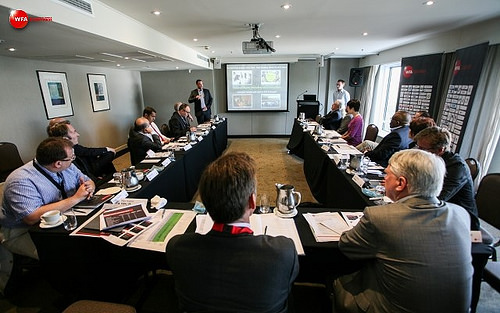WFA global sourcing meetings in New York
19/12/2013
Back to the overview
On 12th December WFA hosted its fourth global marketing sourcing meeting of the year in New York, kindly hosted by Pfizer. The meeting drew around 25 international marketing and media procurement directors, predominantly US based but with global or regional remits. The session saw the release of WFA's 2014 Global Marketing Sourcing Benchmark: a project which helps organisations benchmark their levels of sourcing maturity against a pool of over 60 multinational brands. Case-studies in the meeting were shared by Pfizer, Hershey, Luxottica and Boehringer-Ingelheim, and two guest presentations were led by consultants SPIRE Worldwide and Beekman Associates.
WFA Members will get the full set of take-outs from the meeting (covering media RFIs, agency lifecycle management, agency resource costing and more) but one highlight within discussions was around procurement's relationship with business stakeholders. Much has been made of the perceived gap in expectations between procurement and marketing, and several members shared how their organisations go through cyclical changes in their structure to which procurement must respond. Legacy issues around existing processes, major acquisitions or mergers within the business, and restructuring within the marketing, media and indirect procurement teams all affect the dynamics of how marketing sourcing functions as an internal service provider.
What became clear from the conversations was that many marketing procurement teams have realized that their organizational set up is not always conducive to fostering collaborative stakeholder relationships. Whereas most organisations set up their marketing sourcing teams in a matrix function to cover areas of marketing spend (categories) either locally, regionally or globally, there are other models to consider. One such model involves having procurement directly service a local market, business unit or brand as a generalist (rather than a category expert). They then leverage the expertise of a global team of category experts on a needs basis “in-market”, which in theory means procurement responds to stakeholder requirements much more closely. There are a variety of hybrid approaches in addition which often reflect the hierarchy of where marketing procurement reports into (marketing, marketing operations, indirect procurement, supply chain, finance etc.).
Naturally there is no single structure that will always work, and it was broadly acknowledged that almost every organization uses a subtly different approach, however moving beyond entrenched perspectives on the roles of different functions and focusing instead on how best to serve the business needs was a constant focus of the discussions in the room.
For more information on our SOURCINGFORUM and the ways its services global marketing sourcing and procurement members, please contact Steve Lightfoot [email protected]
Sign up to monthly WFA news
WFA Members will get the full set of take-outs from the meeting (covering media RFIs, agency lifecycle management, agency resource costing and more) but one highlight within discussions was around procurement's relationship with business stakeholders. Much has been made of the perceived gap in expectations between procurement and marketing, and several members shared how their organisations go through cyclical changes in their structure to which procurement must respond. Legacy issues around existing processes, major acquisitions or mergers within the business, and restructuring within the marketing, media and indirect procurement teams all affect the dynamics of how marketing sourcing functions as an internal service provider.
What became clear from the conversations was that many marketing procurement teams have realized that their organizational set up is not always conducive to fostering collaborative stakeholder relationships. Whereas most organisations set up their marketing sourcing teams in a matrix function to cover areas of marketing spend (categories) either locally, regionally or globally, there are other models to consider. One such model involves having procurement directly service a local market, business unit or brand as a generalist (rather than a category expert). They then leverage the expertise of a global team of category experts on a needs basis “in-market”, which in theory means procurement responds to stakeholder requirements much more closely. There are a variety of hybrid approaches in addition which often reflect the hierarchy of where marketing procurement reports into (marketing, marketing operations, indirect procurement, supply chain, finance etc.).
Naturally there is no single structure that will always work, and it was broadly acknowledged that almost every organization uses a subtly different approach, however moving beyond entrenched perspectives on the roles of different functions and focusing instead on how best to serve the business needs was a constant focus of the discussions in the room.
For more information on our SOURCINGFORUM and the ways its services global marketing sourcing and procurement members, please contact Steve Lightfoot [email protected]
Sign up to monthly WFA news
















































































